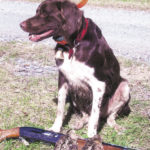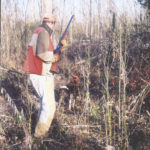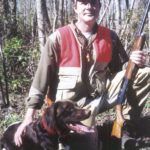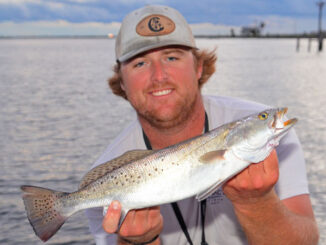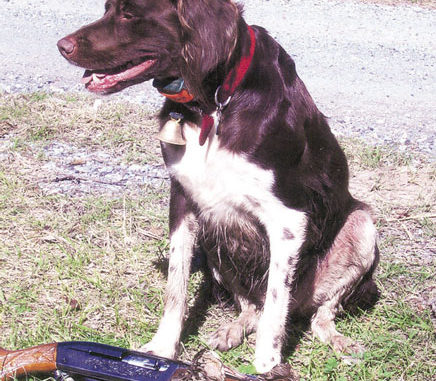
The stretch of bottomland bordering the Atchafalaya River at Whiskey Bay off Interstate 10 is moist from recent winter rains, ready-made for moisture-loving woodcocks.
Telltale leaves on the ground in layers do not crackle underfoot, the sort of commotion that puts resident wildlife on alert. The air, rinsed by the northern showers, is clear and crisp.
Sound carries well, especially the jingle bell on the bird dog’s collar as it tracks a roving woodcock in an ever-widening arc, most of the time unseen by the two hunters weaving around scrub trees and threading gingerly through prickly underbrush with shotguns slanted upward ever at the ready, trying to stay within hearing distance of the spaniel.
Glimpsed fleetingly in the thicket, its short tail is wagging a mile a minute, the bell pealing in stride. White droppings spattered on fallen leaves here and there are woodcock calling cards; sure signs that birds are in the vicinity.
The hunt is just under way when the bell abruptly goes silent. Whereas the merry tinkling was entertaining, the silence is electric.
“Oh boy! Jake’s nailed a woodcock already,” praises one of the hunters.
The other, Jeddie Smith, rangy athletic owner and home trainer of the brown-and-white Brittany, appears not the least bit surprised by the quick find; nevertheless, inner pride over his dog’s performance is evident in his smile. We move forward on the double, never mind the briers. “Woodcock Gunning 101” advises getting to a dog on point quickly. Some days the birds are super skittish and don’t hold tight very long.
Sure enough, we were still a good 10 feet away when the russet bird jumped from cover inches from the dog’s muzzle, and on musical wings flew directly up into the morning sky. The angle of flight wasn’t by choice, rather by necessity; there was no lateral flyway through the tangled undergrowth.
The thicker the better describes the woodcock’s preferred topography in Louisiana and adjacent temporate states, its adopted wintering grounds, ruling out glide landings and horizontal takeoffs. Instead it mimics a Harrier jet, and flutters straight down when alighting and straight up when flushed from cover.
And that’s the challenge when gunning for woodcock in boundless thickets; vertical landings and takeoffs. It usually rises in close range, sometimes so close as to be snagged on the fly by dogs on point.
If the hunter for his part fires too fast and scores a sound hit, the bird will likely be riddled with shot. On the other hand, if he waits for the target to clear the forest canopy, it might disappear behind the crown of the tree, which is what happened on this, the first opportunity of the day for a kill — sprays of gunshot drew leaves and shredded bark from the treetops but no feathers from the bird.
Similar in feather pattern and coloration, the woodcock would fit comfortably in the quail and grouse families of upland game birds save for two notable differences: The woodcock is migratory. Grouse and quail tend to stay on their home turf, and have stubby nutcracker beaks necessary for feeding on tough seeds and grains associated with meadows and farms. The woodcock, on the other hand, sports a long, flexible bill designed for digging worms, its main diet, in soft ground; thus its seasonal migration from frigid north to sultry south.
The woodcock is a European native whose restless relatives live in Nova Scotia, a Canadian province that was at one time also the home of Acadian people.
It’s entirely unrelated, separated in time by hundreds of years, but the coincidence of Acadians and woodcocks exiting the same locations on this unbelievable vast planet with the exact same destination in mind presents a metaphor too tempting to pass up. So the woodcock, all in good humor, becomes the Cajun bird, and in all seriousness long ago inspired Louisiana’a Becasse (woodcock) Chapter of the American Grouse Society. The chapter united to conserve both the woodcock species and the gunning tradition of the interesting bird.
No doubt woodcocks were journeying south, making Louisiana a major wintering ground eons before the Acadian exodus from Canada to the southwest Attakapas in 1755.
Acadians migrated here for political reasons. Among other issues, they disagreed with Britain, who made the rules in Canada at the time, on taxes; they came to stay. Woodcocks, frostline birds, come and go according to Nature’s timetable, namely change of seasons. They stay ahead of harsh winter weather. Since it’s impossible to grub for worms in frozen ground, they travel to the swamps of the Deep South where the digging is easy.
In that regard, it was estimated by field biologists some years back that a majority of the Nova Scotian woodcock population wintering in Louisiana settled along the soggy flanks of the Atchafalaya River. Generally it holds true today although the birds have since expanded their territory, suggesting a rise in numbers.
When it comes to actual woodcock population, Mr. Webster may have had these particular birds in mind when he entered the word “elusive” in his dictionary. The creatures are so secretive they defy counting; guesses are in the thousands; but not how many thousands. Trying to count the number of woodcocks spending the winter months in Louisiana, when they stay hidden in the bushes the entire time, sounds like a frustrating task.
Numerically woodcocks, as with all wildlife, have their up and down times. Perhaps what matters more to sportsmen than precise figures is an observation by Mike Olinde of Louisiana’s Department of Wildlife and Fisheries. Discussing woodcocks with him gives the impression he is confident that the species is presently a sustainable, self-renewable resource.
Ongoing banding projects and other field research indicate there are enough regularly wintering in the state for hunters to continue enjoying an open season and a three-bird bag limit.
Veteran woodcock hunters lean toward cylinder or modified shotguns and light field loads, providing broad shot patterns, in place of full choke bores and hi-brass shells used on waterfowl. Even so, when gunning for woodcock in tight places, a miss now and then is not unusual. A sapling interferes with the swing of a gun barrel, or the bird flies into the blinding sun.
Finding woodcocks in open woods is a rare and welcome change from squeezing through jumbled vegetation, obviously giving hunters clearer shots at fleeing birds and uninterrupted views of hunting dogs at work.
It happens that topnotch woodcock habitat such as extensive natural lowlands and the dewy banks of major rivers in the state, illustrated by the cosmopolitan Mississippi and the primitive Atchafalaya, is also quality deer country. Much but luckily not all of those tracts are leased to private hunting clubs. Unluckily, the two seasons overlap, making it difficult to secure permission to hunt on the posted lands involved.
Owing to these circumstances, the question of where to hunt woodcocks if one doesn’t belong to an organized club often comes up when sportsmen meet at coffee shops.
The answer is, opportunities abound on state lands or one of more than 50 state-maintained wildlife management areas. Since wintering woodcock congregate in damp regions, the areas adjoining lowland streams are more suitable for the sport than rivers with consistently high and dry shores.
Information concerning public hunting on the WMAs is listed in the Hunting Regulations booklet available at Wildlife and Fisheries offices and sporting good stores. Among other specifics listed in the pamphlet, hunter orange is required, and self check-in and check-out is mandatory procedure.
An everyday name for the woodcock is “timberdoodle,” a quaint but in some ways fitting alias. With its peculiar whistling flight, huge, bulbous eyes centered in its head to provide all-direction vision and long, dexterous beak adept at pulling slippery worms from their burrows, it appears outdated, a discontinued model in the avian kingdom compared with, say, the streamlined head of heron.
Clownish looks do not distract from its appeal, however. The woodcock is arguably second only to quail in popularity among outdoorsmen whose passion is bird hunting with the aid of pointers and setters.
Another oddity is the woodcock stomach, which among other organs has no gizzard of a form common in other fowl. In fact, the digestive system couldn’t be simpler. The innards, about the size of a bubblegum ball, have evolved expressly for processing a soft diet as opposed to tough seeds and grains, which require a gizzard for grinding into digestible mash.
A frequent, though by no means exclusive, choice of dogs by woodcock hunters is the Brittany, another European import. Medium-sized, it tracks close to the hunters, an important trait because it is out of sight much of the time, traceable only by sound in brushy terrain.
Lightweight dog bells and electronic beepers are as vital in woodcock hunting as dance bands are at senior proms. The devices tell the hunter where the dog is at all times. If the traditional bell, for instance, suddenly stops ringing, the dog is probably on rigid point.
At such moments, hunter heartbeats quicken. What may have been a routine foray switches gears to an exciting chase with an unpredictable outcome. Despite being a relatively slow flyer, the wily woodcock seldom offers an easy straightaway shot.
Whether a solid hit or an embarrassing miss is registered on a jump, the drama is over in seconds. No use fretting if a bird escapes. Because of the woodcock’s flocking tendency chances are good there are others in the area, other opportunities for the hunter to bag one or two before the day is done and, equally gratifying, more time to enjoy watching a sleek gun dog in its element — seeking out and pinpointing evasive game birds for its
master.
